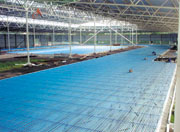
Refrigerant gas supplier Dehon Service Nederland, cooling installation contractor GTI Post Koudetechniek, and refrigerant producer Honeywell Fluorine Products teamed up to build a high-performance, energy-efficient, environmentally friendly, safe cooling installation for a 400-meter speed-skating track and hockey rink in Breda.
GTI Post contacted Dehon to find the best refrigerant for the semi-covered ice stadium. GTI specializes in cooling installations and has wide experience in delivering custom-made equipment for warehouses, product lines, and ice rinks.
Together with Honeywell, Dehon Group (a Honeywell distributor) identified R-410A as the optimal refrigerant for this large-scale application.
The temperature requirements for an ice rink are extraordinary. They must meet the demands of a large surface area and of changing weather conditions (both temperature and humidity), since the stadium is semi-covered and has many uses. The rink is open from October until April, with varied numbers of users at any one time.
THE SYSTEM
The cooling installation was built according to GTI specifications using York compressors with a total capacity of 1,700 kW. A solution of calcium chloride (brine) is cooled in a heat exchange system containing the 410A. The brine is pumped through 90 km of plastic tubing, which was set into the concrete floor when it was poured.To optimize the temperature control, the track is divided into four sections. A separate hockey rink comprises the fifth section. The cold fluid enters the track at four access points. The flow through these sections can be adjusted to obtain the best quality ice possible.
The cooling system’s generated heat is recuperated and re-employed to heat, for example, offices on site and the water for the Zamboni machines that resurface the ice.
Beside the thermal properties, energy efficiency, and environmental impact, public safety played a role in choice of 410A, according to officials. The refrigerant is a near-azeotropic mixture of 50% R-125 and 50% R-32. Those two HFCs have zero ozone-depletion potential. Moreover, the higher capacity of 410A is said to bring greater energy efficiency. The refrigerant is also nontoxic and nonflammable.
Honeywell officials said that these benefits of 410A — plus its use in both a/c and refrigeration — have helped increase interest in the refrigerant. To meet the demand for 410A in particular and HFCs in general, Honeywell is in the process of doubling the production capacity of its fluorocarbon production facility in Geismar, LA. The plant is expected to come on-line in mid-year 2002.
Meanwhile in the Netherlands, there is yet another rink to produce another wave of Olympic-caliber speed skaters.
Publication date: 04/01/2002




